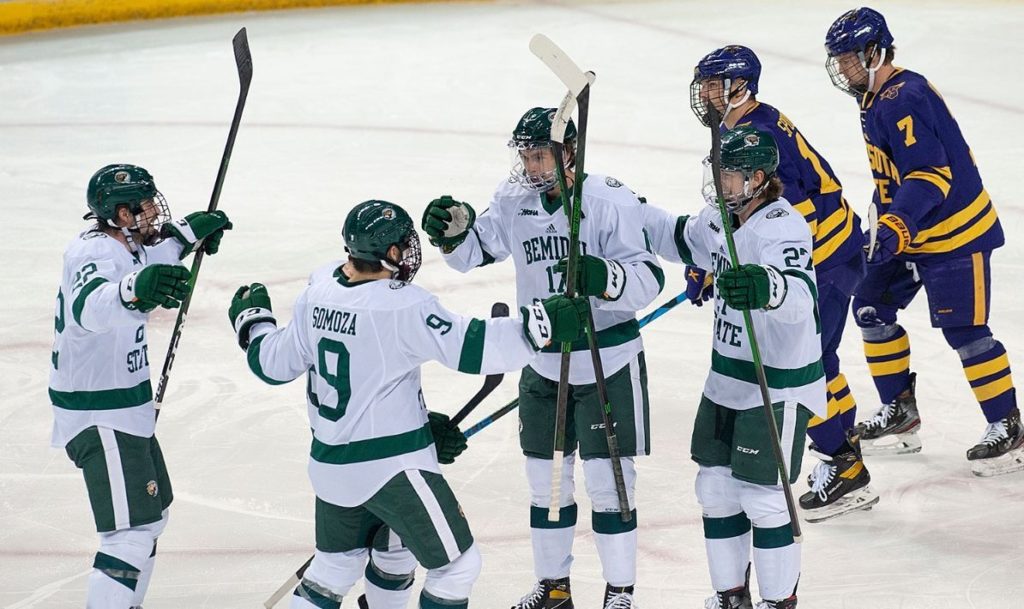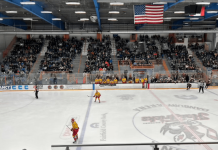
Each week during the season, we look at the big events and big games around Division I men’s college hockey in Tuesday Morning Quarterback.
Paula: Jimmy, last week we jumped right into a discussion of the USCHO.com poll and at the risk of seeming repetitive, I’d like to start with polling as well.
First, the D-I men’s poll and how different the top votes are from a week ago. Without playing a game, Boston College not only retains its position at No. 1 but solidifies it by receiving nine more votes this week than the Eagles did last week. Minnesota – a team that has scored 30 goals in its last four games and outscored opponents 25-5 in the process – jumps from fourth to second with 11 first-place votes.
After splitting with Omaha, North Dakota receives one vote for first place after earning nine last week, and following one loss to Bemidji State, Minnesota State drops from third to sixth and earns no first-place votes after receiving 10 last week.
To me, the differences in these two polls provide the clearest picture of how many people are seeing the overall college hockey picture during a season when it’s nearly impossible to have an overall picture. I see the vote of confidence in Hockey East as a conference. I see the voters liking Minnesota but not necessarily endorsing the Big Ten. And I see voters rethinking the WCHA.
What kind of picture do you see?
Jim: I think your assessment is accurate, particularly when it comes to the WCHA, and with good reasons.
When I look at the WCHA I see two teams – Minnesota State and Bowling Green – with strong overall records. Michigan Tech was making a move until this past weekend when they were swept by Bowling Green.
But there is one team that has been a little bit overlooked, and that’s Bemidji State. Yes, the Beavers are only 6-4-2, a record that maybe doesn’t blow you away. But look at their schedule to date. Over the last eight games, all of Bemidji’s opponents were nationally-ranked at that time. They’ve posted a 5-2-2 record in those nine games and beat Bowling Green three times and earned a tie and win against Minnesota State.
There is a point to make here that is unrelated to the poll. In recent years, the WCHA has rarely placed three teams into the tournament. But when we currently look at Minnesota State and Bowling Green, they seem like locks if the tournament began tomorrow. Then you have Bemidji State that is putting together a heck of a resume.
In Atlantic Hockey, the same can be said for American International at 13-3-0. They’ve been impressive throughout and seem like an NCAA lock, but what if the Yellow Jackets don’t win their conference tournament. If they, say, run the table on the regular season and win a couple of games to get to the AHA finals and lose, they could be 22-4. Could you leave a team with that record home?
These are all hypotheticals, but that’s how my mind is working these days. What says you?
Paula: Without a real idea of how the NCAA selection committee is going to make its decisions, it’s easy for me to say that leaving the Yellow Jackets out of the tournament would be a serious miscarriage of justice. Actually, even without the knowledge of how decisions will be made, should AIC continue as it has and not capture the Atlantic Hockey playoff championship – and, therefore, not capture the AHA autobid – I still say it would be an injustice, precisely because of the nature of this season.
It seems to me that every team with the best win percentage within its conference ought to represent that conference in post-season national play, regardless of whether that team wins or loses its conference playoff championship.
That doesn’t mean it won’t happen. I can see team like American International being left out if the NCAA selection committee bases part of its decision on the number of teams each conference has placed in the tournament in recent seasons and sticks to the playoff autobid. I do think that would be criminally shortsighted.
All of this brings us around again to speculating about the tournament with little other than some intuition and observations about the current state of things to guide us. In my zeal to protect teams that have prevailed through weird and difficult times, I wonder about overlooking teams like Bemidji State that is making an argument for inclusion.
Then there are the teams that just make spectacular runs at the end of a given season and capture that playoff crown and autobid. Should such teams be favored over the teams that have dominated all year? And how much should the NCAA take into consideration the recent representation from each conference?
One more question: How much are we actually seeing that recent postseason representation play out during the regular season, even without the benefit of nonconference play?
Jim: I guess this goes back to what we discussed a few weeks back: should recent proportion of bids by conference be used as a guideline for this year’s tournament. The more I have considered that question, the stronger I feel about my decision. The answer should be no.
The reality is that every season is different.
Let’s think about some recent postseasons when the often-maligned PairWise Rankings helped the eventual national champion barely qualify. Those teams – Yale in 2013, Providence in 2015 and Minnesota Duluth in 2018 – all limped to the finish line and barely made the NCAA tournament but then went on to win it all. They qualified for the tournament because of their body of work throughout the entire season. To me, those are the teams we want to ensure make the field.
If teams get hot down the stretch after a less-than-stellar season, there is still a path to an NCAA bid – win your conference tournament. But besides those six teams, my hope at this point that the NCAA will chose the teams that have been consistent throughout the season, regardless of conference. The one guarantee I will make: when the field is finally selected, there will be one or more teams that are upset about being left out.
On another note, we haven’t discussed in this space that the NCAA needs to find a host for the Northeast Regional after Manchester, N.H., recently pulled out. I don’t know how you fix this, though there are plenty of great on-campus venues in the area that could possibly host.
That leads me to another thought, though. How legitimate might the term “regional” be this year? Might the NCAA attempt to take the four closest teams to a region and place them together in order to eliminate as much travel as possible? Certainly wherever the Northeast Regional ends up and the current East Regional site, Bridgeport, Conn., are both surrounded by plenty of college hockey teams. But Fargo, N.D., the Midwest host and Loveland, Colo., the West host, are a little bit isolated, particularly Loveland.
Paula: Since Manchester dropped that regional, I’ve been thinking about this quite a bit. I have been mulling over what UNH director of athletics Marty Scarano said in the statement that accompanied the announcement, that UNH felt that they “could not do justice to hosting” the regional.
I mean, seriously, who can “do justice” to hosting an event of this kind during a global pandemic? I’m not dismissing what Scarano said, but I do nearly always wish for a little more transparency, like a real statement about how the pandemic would impact the hosts financially. I appreciate the genuine concerns for addressing safety issues and I know it’s unfair to expect anyone in Scarano’s position to be as transparent as I’d like.
Given the abysmal attendance at many regionals in recent years, now would be a very good time for the NCAA to reconsider its approach to regional sites and in the name of transparency, I absolutely am arguing that the NCAA should abandon what it’s been doing for years and return the regionals to on-campus sites.
(And while we’re talking about regional legitimacy, Allentown, Penn., is three hours east of Penn State, less than two hours from Manhattan, and is scheduled to host the Midwest Regional in 2022, 2023 and 2025.)
I was hoping that UNH’s withdrawal from hosting might prompt the NCAA to consolidate the entire tournament in Pittsburgh, or if that wasn’t possible, at least move the field of 16 to one site somewhere.
Even non-pandemic years, I don’t understand the rationale behind the far-flung geography when attendance outside of the northeast runs from awful to spotty to occasionally substantial. Local coverage of the event outside of the northeast is also inconsistent, so it doesn’t appear that the setup does a lot to raise the profile of the sport, either. I haven’t heard any rumblings, though, of the NCAA considering moving to a single site for safety reasons.
Yes, I know I just ranted quite a bit. As someone who has covered many sparsely attended Midwest Regionals – or missed them altogether because they’re not really held in the Midwest – I’m passionate about bringing these back to campuses and consolidating this year.
Jim: From what I have been told by a few different people, there were conversations about possibly moving the entire tournament to Pittsburgh, something that looks like it could work judging by building availability, at least, at PPG Paints Arena. But those conversations ended in a dedication to leaving things status quo. That was before Manchester announced it wouldn’t host.
As for campus sites and moving regionals back, I’ve always supported that. Though this probably isn’t the year for that as I can’t even imagine that every campus would even want more games. Consider this: we have six weeks or so remaining in the regular season and one school – Maine – still hasn’t allowed the team to play a single home game. So I’m not sure the NCAA would be very welcomed there.
All of these hypothetical questions will continued to be debated until the NCAA answers them publicly.

